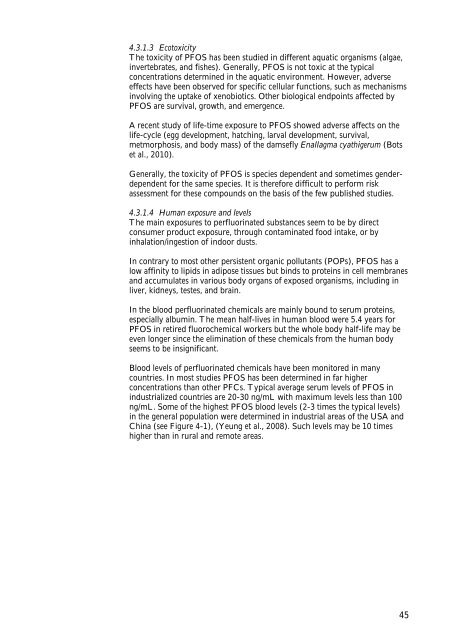Substitution of PFOS for use in nondecorative hard chrome plating
Substitution of PFOS for use in nondecorative hard chrome plating
Substitution of PFOS for use in nondecorative hard chrome plating
You also want an ePaper? Increase the reach of your titles
YUMPU automatically turns print PDFs into web optimized ePapers that Google loves.
4.3.1.3 Ecotoxicity<br />
The toxicity <strong>of</strong> <strong>PFOS</strong> has been studied <strong>in</strong> different aquatic organisms (algae,<br />
<strong>in</strong>vertebrates, and fishes). Generally, <strong>PFOS</strong> is not toxic at the typical<br />
concentrations determ<strong>in</strong>ed <strong>in</strong> the aquatic environment. However, adverse<br />
effects have been observed <strong>for</strong> specific cellular functions, such as mechanisms<br />
<strong>in</strong>volv<strong>in</strong>g the uptake <strong>of</strong> xenobiotics. Other biological endpo<strong>in</strong>ts affected by<br />
<strong>PFOS</strong> are survival, growth, and emergence.<br />
A recent study <strong>of</strong> life-time exposure to <strong>PFOS</strong> showed adverse affects on the<br />
life-cycle (egg development, hatch<strong>in</strong>g, larval development, survival,<br />
metmorphosis, and body mass) <strong>of</strong> the damsefly Enallagma cyathigerum (Bots<br />
et al., 2010).<br />
Generally, the toxicity <strong>of</strong> <strong>PFOS</strong> is species dependent and sometimes genderdependent<br />
<strong>for</strong> the same species. It is there<strong>for</strong>e difficult to per<strong>for</strong>m risk<br />
assessment <strong>for</strong> these compounds on the basis <strong>of</strong> the few published studies.<br />
4.3.1.4 Human exposure and levels<br />
The ma<strong>in</strong> exposures to perfluor<strong>in</strong>ated substances seem to be by direct<br />
consumer product exposure, through contam<strong>in</strong>ated food <strong>in</strong>take, or by<br />
<strong>in</strong>halation/<strong>in</strong>gestion <strong>of</strong> <strong>in</strong>door dusts.<br />
In contrary to most other persistent organic pollutants (POPs), <strong>PFOS</strong> has a<br />
low aff<strong>in</strong>ity to lipids <strong>in</strong> adipose tissues but b<strong>in</strong>ds to prote<strong>in</strong>s <strong>in</strong> cell membranes<br />
and accumulates <strong>in</strong> various body organs <strong>of</strong> exposed organisms, <strong>in</strong>clud<strong>in</strong>g <strong>in</strong><br />
liver, kidneys, testes, and bra<strong>in</strong>.<br />
In the blood perfluor<strong>in</strong>ated chemicals are ma<strong>in</strong>ly bound to serum prote<strong>in</strong>s,<br />
especially album<strong>in</strong>. The mean half-lives <strong>in</strong> human blood were 5.4 years <strong>for</strong><br />
<strong>PFOS</strong> <strong>in</strong> retired fluorochemical workers but the whole body half-life may be<br />
even longer s<strong>in</strong>ce the elim<strong>in</strong>ation <strong>of</strong> these chemicals from the human body<br />
seems to be <strong>in</strong>significant.<br />
Blood levels <strong>of</strong> perfluor<strong>in</strong>ated chemicals have been monitored <strong>in</strong> many<br />
countries. In most studies <strong>PFOS</strong> has been determ<strong>in</strong>ed <strong>in</strong> far higher<br />
concentrations than other PFCs. Typical average serum levels <strong>of</strong> <strong>PFOS</strong> <strong>in</strong><br />
<strong>in</strong>dustrialized countries are 20-30 ng/mL with maximum levels less than 100<br />
ng/mL. Some <strong>of</strong> the highest <strong>PFOS</strong> blood levels (2-3 times the typical levels)<br />
<strong>in</strong> the general population were determ<strong>in</strong>ed <strong>in</strong> <strong>in</strong>dustrial areas <strong>of</strong> the USA and<br />
Ch<strong>in</strong>a (see Figure 4-1), (Yeung et al., 2008). Such levels may be 10 times<br />
higher than <strong>in</strong> rural and remote areas.<br />
45

















